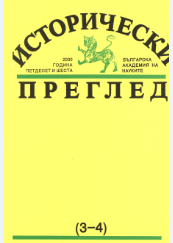Константинопол през погледа на своите жители от елита и простолюдието (втората половина на IX – началото на XI век)
Constantinople in the Eyes of Its Inhabitants. Intellectual and Popular Attitudes (Second Half of 9th – at the Beginning of 11th Century)
Author(s): Liliana SimeonovaSubject(s): History, Cultural history, History of ideas, Social history, Middle Ages, 6th to 12th Centuries
Published by: Институт за исторически изследвания - Българска академия на науките
Keywords: Constantine Porphyrogenitus; New Rome; New Jerusalem; Byzantine emperors
Summary/Abstract: The assertion of Constantine Porphyrogenitus that “the Imperial City had supremacy over the whole world” was, in the minds of its inhabitants, a universally acknowledged truth. Encomiasts praised the City as being “the eye of the Earth”. According to the contemporary imperial propaganda, Constantinople was the New Rome and the New Jerusalem. Its palace was a reflection of the Heavenly Zion, its court and public ceremonial illustrated the relationship between God and Emperor, Heaven and Earth.In Byzantine eyes, Constantinople was the epitome of the Christian Roman empire: the epithet “New Rome” applied to both the City and the country. Seen as the centre of the Roman-Christian civilization, throughout the centuries Constantinople was amply eulogized by poets and writers. As could be seen from the works of the elite writers, the New Rome’s self-image was centred on the ideas that Constantinople was the continuous beneficiary of divine favour and would last till the end of time; that it was the abode of holy people as well as of Wisdom itself and that, in valour, its generals surpassed the famous generals o f Antiquity. Above all, however, imperial propaganda exploited the idea that the City was a Constantinian foundation which would never fall to an enemy. In the letters, which the Byzantine emperors and patriarchs of the 860s through the 1020s wrote to foreign rulers or the popes of Rome, Constantinople was often identified with the divinely instituted imperial power. The elite also took pride in the City landmarks whose beauty they praised in verse or prose. At the same time, the city population continued to believe that Constantinople and the empire would end. The popular beliefs concerning the origins, development and ultimate fate of the City have found reflection, above all, in the writings of the so-called patriographs. As could be seen from the patriographic works, many late antique inscriptions on the pedestals of statues and reliefs were interpreted, by the city-dwellers of Constantinople, as oracles predicting its fall. Those predictions reflected the fears that Constantinople would eventually be destroyed that were felt at all levels of society. As has been noted by C. Mango, the belief that Constantinople would never fall was opposed by the contrary conviction, that Constantinople was ultimately destined to fall, which was current at the same time. The mass of the city population seemed to have hesitated between the concepts of the greatness of their empire and its capital, which the imperial propaganda impressed upon them, on the one hand, and the belief in the unavoidable end of the City, on the other. As for the ruling and educated elite, with their rediscovery of the ancient traditions, they certainly assumed the classical past as their inheritance; this cultural tradition allowed the educated Constantinopolitans to distinguish themselves from the “barbaric” foreigners in the capital, as well as from the less cultured newcomers from the provinces.
Journal: Исторически преглед
- Issue Year: 2000
- Issue No: 3-4
- Page Range: 16-29
- Page Count: 14
- Language: Bulgarian
- Content File-PDF

